Reflecting on World Wetlands Day 2024
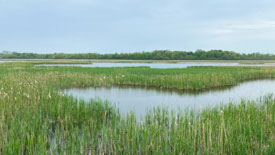
Florian Diamante Nature Reserve wetland on Pelee Island, ON. Photo by Gen Pintel/NCC staff.
Today, February 2, marks World Wetlands Day, and at the Nature Conservancy of Canada (NCC), it’s an occasion to reflect on the importance of wetlands.
Wetlands are ecosystems that include bogs, peatlands, marshes, rivers, lakes, deltas, floodplains and flooded forests. One quarter of the world’s wetlands are found in Canada. The environmental benefits provided by wetlands are varied and numerous, including filtering water, storing carbon, and absorbing and holding water to act as buffers for nearby communities from flood and drought. Hundreds of plant and animal species depend on wetland habitats.
In southern Canada, an estimated 70 per cent of wetlands have been lost due to development.
We can act now to protect the wetlands that remain and restore what has been lost. Thanks to the support of landowners and donors, NCC has ensured a future for nearly 168,000 hectares of wetlands across 924 properties. Together, we can continue conserving and caring for these vital and vulnerable ecosystems.
Read on to learn about a few of NCC’s projects across Canada that are protecting and restoring wetlands, while building hope for a thriving natural world for all.
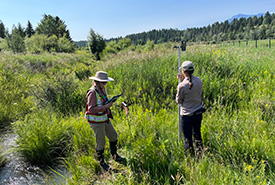
NCC staff surveying at Thunder Hill Ranch, BC (Photo by Haley MacDonald/NCC Staff)
British Columbia – Marion Creek wetland restoration
NCC is currently working on wetland restoration in the Upper Columbia Valley. The project at Marion Creek, on Thunder Hill Ranch, involves digging a series of connected wetland pools and creating deep, low-banked streams to allow excess water to flow over the floodplain. This work will improve habitat for an important population of at-risk westslope cutthroat trout. Logs and rocks will also be added to provide habitat for aquatic invertebrates and amphibians, while shoreline work will increase habitat for burrowing species, like Columbia ground squirrel and American badger.
The former streams here were diverted into drainage ditches for agricultural irrigation in the 1960s. This damaged important habitat for fish, amphibians and burrowing species, and allowed invasive species to take hold.
In 2023, NCC and partners completed some initial work, which included repairing a diversion ditch to temporarily divert the stream during the project. Wetland construction will begin in fall 2024.
Learn more about NCC's work at Thunder Hill Ranch here >
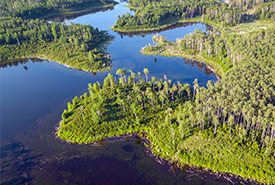
Moose Pasture, AB (Photo by NCC)
Alberta – Beaver Hills conservation campaign
Located just east of Edmonton, the Beaver Hills feature “knob and kettle” topography, a form of glacial landform characterized by high areas (the “knob”) interspersed with low-lying depressions (the “kettle”). These kettles result in a wetland-rich landscape with many wetlands of varying sizes and types, resulting in high biodiversity.
Elk Island National Park and the Miquelon Lake Provincial Park are both found in the Beaver Hills. NCC’s work here aims to increase connectivity between these publicly-protected areas through private land conservation.
The latest NCC project in this effort is Moose Pasture, located just east of Elk Island National Park. This 65-hectare property features extensive open water wetlands and is home to moose, red-necked grebe and western toad.
Learn more about the Beaver Hills here >
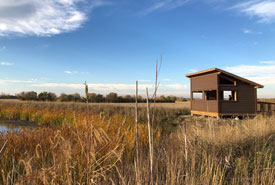
Wildlife viewing blind at the Florian Diamante Nature Reserve, ON. Photo by Jill Crosthwaite/NCC staff.
Ontario – Florian Diamante Nature Reserve
In 2023, after five years of work, NCC completed a wetland restoration project at the 184-hectare Florian Diamante Nature Reserve on Pelee Island in Lake Erie. Twenty-five hectares of wetlands were restored here. Pelee Island’s unique biodiversity provides habitat for hundreds of species of migratory birds each spring, among many other species.
Prior to European settlement, Pelee Island was a series of smaller islands connected by marshes. In the late 1800s, the marsh was drained for agriculture, with farming continuing at the restored area until 2020. The wetland restoration project required removing drainage pipes, constructing a berm to retain water and planting native species. A wildlife viewing blind and trail were built to welcome visitors.
NCC will continue stewardship activities at the nature reserve, including maintaining the visitor infrastructure.
Learn more about the restoration project here >
Quebec – The Great Jacques-Cartier Bog
In 2023, NCC announced the acquisition of 200 hectares of bog northwest of Quebec City. The land is part of a broad, 660-hectare wetland area called the Great Jacques-Cartier Bog. Species at risk, including bank swallow, find refuge here, while the peatlands are a feeding and nesting area for other birds.
This NCC project is also a site for research: Université du Québec à Montréal, an NCC partner, is conducting a major study on carbon capture and climate change at the bog. The research aims to quantify and map, over a three-year period, the carbon stores contained in southern Quebec wetlands.
In the meantime, NCC will continue conservation efforts for major peatlands in Quebec, including the Jacques-Cartier bog.
Learn more about research at the Great Jacques-Cartier Bog here >
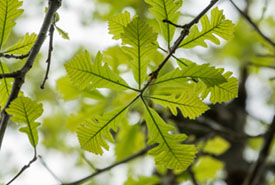
Bur Oak Leaves at the Keyhole, NB (Photo by Courtney Cameron/ NCC Staff)
New Brunswick – The Keyhole
Along the west side of Grand Lake, in central New Brunswick, lies a stunning cove known as The Keyhole. Grand Lake, the largest lake in the province, connects to the Wolastoq (Saint John) River system. Protecting wetlands and forests in this area is a conservation priority for NCC.
The wetlands and forest at The Keyhole, Grand Lake and the Wolastoq River valley help capture and hold excessive water. Permanent protection of the watershed’s lands and forests will help improve water storage capacity. Our work here improves the land’s ability to absorb and hold water to lessen the effects of seasonal flooding and extreme precipitation events in the region.
NCC has protected a 90-hectare nature reserve at The Keyhole, including wetlands, and a mature floodplain forest that features a population of rare bur oak that is more than 200 years old.
Learn more about The Keyhole, Grand Lake and the Wolastoq River valley here >
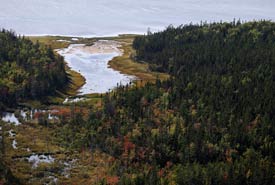
Forests and wetlands of Percival River, PEI (Photo by Mike Dembeck)
Prince Edward Island – Percival River
One of the shining examples of wetlands in Prince Edward Island is located along the Percival River in Prince County. Since 2007, NCC has been protecting coastal salt marsh, freshwater wetlands and nearby black spruce forest in the area.
With the largest unbroken tract of salt marsh in PEI, the Percival River area is one of the most intact wildlife and habitat corridors in the province. It is vitally important for migratory waterfowl, shorebirds and seabirds.
NCC is proud to work in collaboration with conservation partners on PEI to conserve the forest and coastal habitats found here.
Learn more about how, together, we can protect this important habitat >
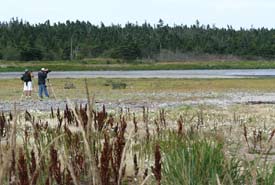
Birders at Big Pond Cove, Brier Island, NS (Photo by NCC)
Nova Scotia – Brier Island Nature Reserve
Since 1988, NCC and partners have been actively working to protect biodiversity at the Brier Island Nature Reserve, located on the western tip of Nova Scotia.
The wetland habitat found here is key to the survival of a diverse range of plants, such as eastern mountain avens. The area's peat bogs are home to 95 per cent of the Canadian population of this rare flowering plant. More than 100,000 migratory birds visit this rich wetland habitat annually.
Our ongoing efforts to restore the Big Meadow Bog, part of the nature reserve, includes support from volunteers, donors, research groups and our conservation partners: Environment and Climate Change Canada, Nova Scotia Department of Natural Resources and Renewables, Mersey Tobeatic Research Institute, Acadia University and the Southwest Biosphere Region Association.
Major upgrades are planned for the Brier Island Coastal Trail, and NCC is actively seeking opportunities and additional support to expand the nature reserve. One third of the island’s total area, 406 hectares, is protected.
Learn more about NCC’s work on Brier Island here >
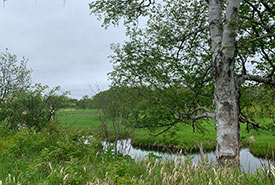
Black Ash Nature Reserve, NL (Photo by Julia Ball/NCC)
Newfoundland and Labrador – Black Ash Nature Reserve
NCC’s Black Ash Nature Reserve is 11 hectares of marshland and floodplain forests along Rocky Brook, less than two kilometres from the town of Deer Lake.
Located within the Upper Humber River Floodplain, this unique property floods seasonally, making it great habitat for provincially rare species, such as black ash, rusty blackbird and great blue heron.
Learn more about our work to protect and conserve black ash trees >




